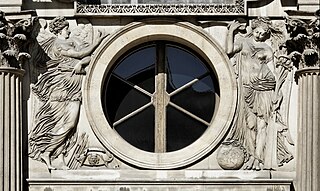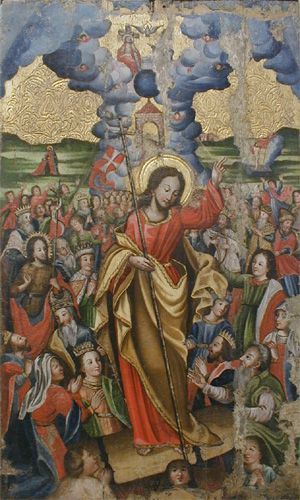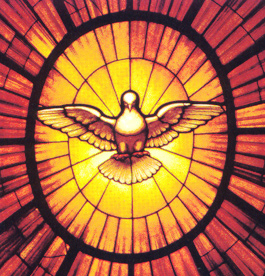In Judaism, the Holy Spirit, otherwise known as the Holy Ghost, is the divine force, quality and influence of God over the universe or his creatures. In Nicene Christianity, the Holy Spirit is the third person of the Trinity. In Islam, the Holy Spirit acts as an agent of divine action or communication. In the Baha’i Faith, the Holy Spirit is seen as the intermediary between God and man and "the outpouring grace of God and the effulgent rays that emanate from His Manifestation".

Pentecost is a Christian holiday which takes place on the 49th day after Easter Day. It commemorates the descent of the Holy Spirit upon the Apostles of Jesus while they were in Jerusalem celebrating the Feast of Weeks, as described in the Acts of the Apostles. The Catholic Church believes the Holy Spirit descended upon Mary, the mother of Jesus, at the same time, as recorded in the Acts of the Apostles.

Cathedrals, collegiate churches, and monastic churches like those of abbeys and priories, often have certain complex structural forms that are found less often in parish churches. They also tend to display a higher level of contemporary architectural style and the work of accomplished craftsmen, and occupy a status both ecclesiastical and social that an ordinary parish church rarely has. Such churches are generally among the finest buildings locally and a source of regional pride. Many are among the world's most renowned works of architecture. These include St Peter's Basilica, Notre-Dame de Paris, Cologne Cathedral, Salisbury Cathedral, Antwerp Cathedral, Prague Cathedral, Lincoln Cathedral, the Basilica of Saint-Denis, Santa Maria Maggiore, the Basilica of San Vitale, St Mark's Basilica, Westminster Abbey, Saint Basil's Cathedral, Antoni Gaudí's incomplete Sagrada Família and the ancient cathedral of Hagia Sophia in Istanbul, now a mosque.

A baptismal font is an ecclesiastical architectural element, which serves as a receptacle for baptismal water used for baptism, as a part of Christian initiation for both rites of infant and adult baptism.

Baroque architecture is a highly decorative and theatrical style which appeared in Italy in the late 16th century and gradually spread across Europe. It was originally introduced by the Catholic Church, particularly by the Jesuits, as a means to combat the Reformation and the Protestant church with a new architecture that inspired surprise and awe. It reached its peak in the High Baroque (1625–1675), when it was used in churches and palaces in Italy, Spain, Portugal, France, Bavaria and Austria. In the Late Baroque period (1675–1750), it reached as far as Russia, the Ottoman Empire and the Spanish and Portuguese colonies in Latin America. In about 1730, an even more elaborately decorative variant called Rococo appeared and flourished in Central Europe.

In architecture, a corbel is a structural piece of stone, wood or metal jutting from a wall to carry a superincumbent weight, a type of bracket. A corbel is a solid piece of material in the wall, whereas a console is a piece applied to the structure. A piece of timber projecting in the same way was called a "tassel" or a "bragger" in England.
The Azusa Street Revival was a historic series of revival meetings that took place in Los Angeles, California. It was led by William J. Seymour, an African-American preacher. The revival began on April 9, 1906, and continued until roughly 1915.

Trinity Sunday is the first Sunday after Pentecost in the Western Christian liturgical calendar, and the Sunday of Pentecost in Eastern Christianity. Trinity Sunday celebrates the Christian doctrine of the Trinity, the three Persons of God: the Father, the Son, and the Holy Spirit.

An oculus is a circular opening in the center of a dome or in a wall. Originating in classical architecture, it is a feature of Byzantine and Neoclassical architecture.
In Christian theology, baptism with the Holy Spirit, also called baptism in the Holy Spirit or baptism in the Holy Ghost, has been interpreted by different Christian denominations and traditions in a variety of ways due to differences in the doctrines of salvation and ecclesiology. It is frequently associated with incorporation into the Christian Church, the bestowal of spiritual gifts, and empowerment for Christian ministry. Spirit baptism has been variously defined as part of the sacraments of initiation into the church, as being synonymous with regeneration, or as being synonymous with Christian perfection. The term baptism with the Holy Spirit originates in the New Testament, and all Christian traditions accept it as a theological concept.

Eastertide or Paschaltide is a festal season in the liturgical year of Christianity that focuses on celebrating the Resurrection of Jesus Christ. Preceded by Lent, it begins on Easter Sunday, which initiates Easter Week in Western Christianity, and Bright Week in Eastern Christianity.

The Tree of Jesse is a depiction in art of the ancestors of Jesus Christ, shown in a branching tree which rises from Jesse of Bethlehem, the father of King David. It is the original use of the family tree as a schematic representation of a genealogy.
Christian symbolism is the use of symbols, including archetypes, acts, artwork or events, by Christianity. It invests objects or actions with an inner meaning expressing Christian ideas.

The Church of Saint-Bruno des Chartreux is a Roman Catholic church located in Lyon, France. Until the French Revolution, it was the church of Lyon Charterhouse. The cathedral is dedicated to Saint Bruno of Cologne, also known as Saint Bruno of the Carthusians, and is the city's only Baroque church.

Erschallet, ihr Lieder, erklinget, ihr Saiten!, BWV 172, is a church cantata by Johann Sebastian Bach, composed in Weimar for Pentecost Sunday in 1714. Bach led the first performance on 20 May 1714 in the Schlosskirche, the court chapel in the ducal Schloss. Erschallet, ihr Lieder is an early work in a genre to which he later contributed complete cantata cycles for all occasions of the liturgical year.

For the majority of Christian denominations, the Holy Spirit, or Holy Ghost, is believed to be the third divine person of the Trinity, a triune god manifested as God the Father, God the Son, and God the Holy Spirit, each being God. Nontrinitarian Christians, who reject the doctrine of the Trinity, differ significantly from mainstream Christianity in their beliefs about the Holy Spirit. In Christian theology, pneumatology is the study of the Holy Spirit. Due to Christianity's historical relationship with Judaism, theologians often identify the Holy Spirit with the concept of the Ruach Hakodesh in Jewish scripture, on the theory that Jesus was expanding upon these Jewish concepts. Similar names, and ideas, include the Ruach Elohim, Ruach YHWH, and the Ruach Hakodesh. In the New Testament the Holy Spirit is identified with the Spirit of Christ, the Spirit of Truth, and the Paraclete (helper).

Auf Christi Himmelfahrt allein, BWV 128, is a church cantata by Johann Sebastian Bach. Bach composed it in Leipzig for the Feast of the Ascension and first performed it on 10 May 1725.

Wer mich liebet, der wird mein Wort halten, BWV 59, is a church cantata by Johann Sebastian Bach. He composed the cantata for Pentecost and probably first performed it in Leipzig on 28 May 1724, but an earlier performance on 16 May 1723 at the Paulinerkirche, the University Church of Leipzig, is possible.

The Church of the Holy Ghost or Church of the Holy Spirit is a medieval Lutheran church in the old town district of Tallinn, Estonia. It is located behind Raekoja plats, and lies opposite the Great Guild and Maiasmokk, Tallinn's oldest café.

The Church of the Poor Clares dedicated to Assumption of the Blessed Virgin Mary is an historical church in Gdańska Street, Bydgoszcz, Poland.






















